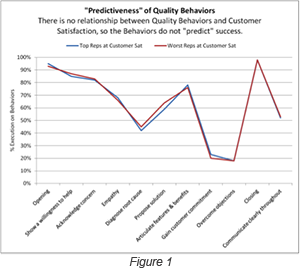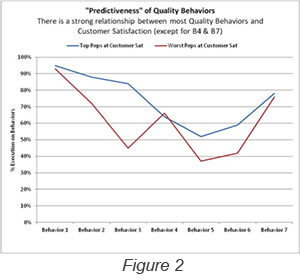A Quality Revolution has been emerging in the last two years, transforming underleveraged and underperforming Quality & Call Monitoring Programs into predictors and drivers of performance improvement. The centerpiece of the revolution is Strategic Quality Assurance (sQA), and it works because it blends equal parts art and science.
In the first two articles, I exposed the Dirty Little Secret in Conventional Quality, and then described the art of embracing subjectivity when you define your behaviors, so you better capture the essence of the customer interaction.
That brings us to Key #2: Correlating and Measuring Predictiveness, which adds the science and mathematical rigor to those subjective behaviors as a check and balance.
The Problem with Conventional Quality: Most organizations don’t know if their Quality Behaviors truly matter
Do you remember the movie Moneyball? In the movie, a baseball team’s General Manager decided that typical measurements of a player’s performance weren’t truly indicative of that player’s value, and they weren’t predictive of future performance. He set about identifying which stats truly do matter, and in so doing, he was able to better quantify the value of the team he put on the field.
Quality Programs are at the same juncture right now. Most Quality Programs are built on behaviors that somebody – no doubt with good intentions – felt were really important to drive Customer Experience, Sales, or other KPIs.
Here’s the problem: In 9 out of the last 10 Quality Programs I’ve studied, the Quality Behaviors have almost exactly zero correlation to KPI success or customer experience. Think about that: These reps want to do the right thing, but their conventional Quality Program has created an over-regimented environment that makes that impossible.

So why hadn’t leadership fixed this? Because they didn’t realize that the behaviors didn’t correlate to KPIs. They had never asked. They had never measured. And when their multi-million-dollar Coaching Transformation resulted in flat KPIs, nobody could figure out why. The real issue was that they were measuring and coaching to the wrong behaviors, behaviors that just didn’t matter to the Customer Experience, Sales, or other KPIs.
This problem should matter a great deal to all levels of a contact center. If the Behaviors don’t correlate to KPIs, then:
- Reps won’t trust that the feedback they receive from Quality will help them get better. This drives down Front Line morale because they feel like leadership is driving them to do things that hurt rather than help. (In many environments, only 35-40% of reps see value in the feedback they receive from Quality).
- Supervisors will be grasping at straws for which behaviors to coach to to drive results. If you need to improve your Rep’s performance at, say, Customer Satisfaction, but you don’t know which behaviors matter the most to Customer Satisfaction, what do you do?
- Leadership may fail to see ROI from their coaching or other performance initiatives, if they are targeted at behaviors that just don’t matter. Despite the fact that an effective Quality program is essential to coaching efforts, Quality is almost always dismissed and undervalued as a strategic lever to drive performance improvement.
The Solution: Correlate Behaviors to KPIs
The companies leading the Quality Revolution follow the Moneyball example, and correlate their behaviors to performance.
Let’s take the same example from above. After redefining their behaviors (and “embracing subjectivity” in those definitions), the executives began measuring the correlations in every site, and across the enterprise twice a year. In figure 2, you’ll see what they saw:

Reps who are the top performers at their most important KPI – Customer Satisfaction – are alsoperforming the Quality Behaviors more consistently. In fact, the relationship is extremely strong. Look at Behavior 3. The Best Customer Satisfaction Reps perform Behavior 3 nearly 40% more often. Imagine if you were a Supervisor coaching a Rep on Customer Satisfaction. You might choose to make Behavior 3 a major focus of your coaching session, because both you and the Rep know that Behavior 3 matters to performance.
Using Correlations as a Leadership Tool
Not all behaviors on the graph are as well-correlated to Customer Satisfaction as Behavior 3. There are a couple of behaviors that have moderate correlations. But there are also three behaviors (B1, B4, and B7) that seem to have no relationship to Customer Satisfaction. Now, maybe those behaviors are being measured for a different reason. Maybe they are compliance behaviors, for example. But in this case, they were actually intended to drive Customer Satisfaction.
Is this bad news? No. This is incredible news for this organization. Because they now know which behaviors they need to improve. They can use this data to go back and investigate why B1, B4, and B7 have such weak correlations, and determine if they should change how they’ve defined those behaviors, change how they calibrate on those behaviors… or maybe just cut those behaviors, so the Reps only have to worry about behaviors that do matter.
Knowledge is power. And in Strategic Quality Assurance, the most powerful knowledge is in your correlations.
What’s Next: Join the Quality Revolution by Building out the Rest of Your sQA Program
So now, we’ve investigated the importance of embracing subjectivity in behaviors, and correlating and measuring predictiveness of those behaviors.
The next article is critical, and continues the theme of adding science and rigor to Quality. Key #3: Automate Calibration describes how you can use technology to quantify how well calibrated your organization is on each one of your behaviors.
The Quality Revolution
Read the complete series of articles for a roadmap to transforming your Quality Program into Strategic Quality Assurance (sQA), and making it a lever for performance improvement:


